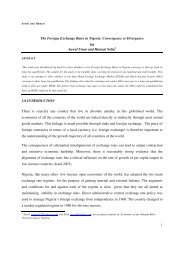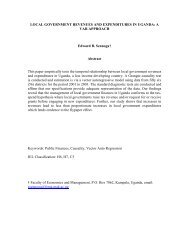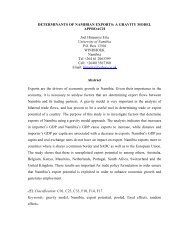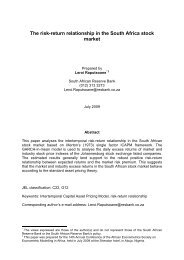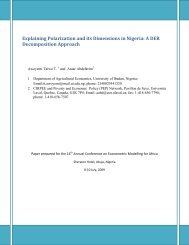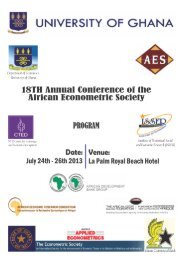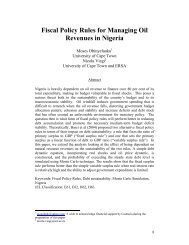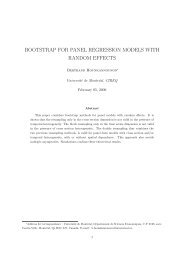Dynamic Effects of Monetary Policy Shocks in Malawi* - African ...
Dynamic Effects of Monetary Policy Shocks in Malawi* - African ...
Dynamic Effects of Monetary Policy Shocks in Malawi* - African ...
Create successful ePaper yourself
Turn your PDF publications into a flip-book with our unique Google optimized e-Paper software.
B-2.0. Co<strong>in</strong>tegrated SVAR AnalysisEstimation results from the co<strong>in</strong>tegrated structural VAR are generally similar to those from thelevels estimation carried <strong>in</strong> l<strong>in</strong>e with Sims, Stock and Watson (1990). Understandably, a number<strong>of</strong> differences also show up. Among the differences, impulse responses from the co<strong>in</strong>tegratedSVAR die <strong>of</strong>f very quickly compared to those from the estimation <strong>in</strong> levels. In order to reta<strong>in</strong>clear visual images, the forecast horizon is reduced from 60 months <strong>in</strong> the levels estimation to12-month <strong>in</strong> the co<strong>in</strong>tegrated SVAR.The co<strong>in</strong>tegrated SVAR confirms the f<strong>in</strong>d<strong>in</strong>g <strong>in</strong> the levels estimation that monetary policy <strong>in</strong>Malawi employs hybrid operat<strong>in</strong>g procedures, with the bank rate and reserve money as operat<strong>in</strong>gtools. Both the bank rate and reserve money respond significantly to shocks <strong>in</strong> the three<strong>in</strong>termediate targets <strong>of</strong> monetary policy namely exchange rates, aggregate money supply andbank lend<strong>in</strong>g (see Figure B1), reveal<strong>in</strong>g that the central bank is concerned with movements <strong>in</strong> thethree targets and to achieve desired levels <strong>in</strong> these targets, the two policy tools are used.Consistent with the levels estimation, the co<strong>in</strong>tegrated SVAR also shows that the exchange rateand money effect are important channels <strong>of</strong> monetary transmission <strong>in</strong> the country, though theimpact is not as pronounced as <strong>in</strong> the levels estimation. The effect <strong>of</strong> bank lend<strong>in</strong>g <strong>in</strong> themonetary transmission process, however, is <strong>in</strong>significant <strong>in</strong> the co<strong>in</strong>tegrated SVAR, whichcontradicts the f<strong>in</strong>d<strong>in</strong>g <strong>in</strong> the levels estimation.The observed differences from the two estimation approaches are not unexpected. An importantsource <strong>of</strong> these differences is the imposition <strong>of</strong> what may be possibly <strong>in</strong>correct co<strong>in</strong>tegrat<strong>in</strong>grestrictions <strong>in</strong> the process <strong>of</strong> estimat<strong>in</strong>g the co<strong>in</strong>tegrated VAR. Kim and Roub<strong>in</strong>i (2000) andBecklelmans (2005) argue that this is usually the case <strong>in</strong> co<strong>in</strong>tegrated VARs with the implicationthat the result<strong>in</strong>g <strong>in</strong>ferences are <strong>of</strong>ten <strong>in</strong>correct as well. In an attempt to circumvent the problem,some studies opt for a simple differences specification (see, for example, Weitong (2007);Boiv<strong>in</strong> & Giannoni (2002); Kasa & Popper (1997); Kugler et al (2004); Karame & Olmedo(2002); Mihira & Sugihara (2000)). The approach, however, is not persuasive as it yields<strong>in</strong>consistent estimates if some variables are co<strong>in</strong>tegrated (Bernanke & Mihov, 1997).vi | P a g e



